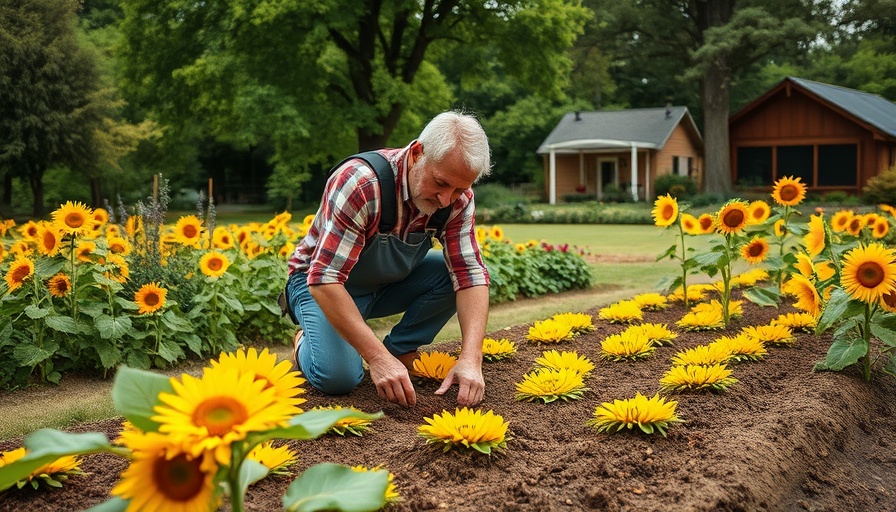
Gathering Around the Sun: The Joy of Gardening
For homeowners passionate about nurturing their gardens, the Sunflower Fort experience offers an exciting way to blend beauty and utility in outdoor spaces. With their bright hues and sturdy structure, sunflowers provide more than just vibrant blooms; they also create a natural fortress that fosters social connections among those who tend to them. Let’s explore why cultivating sunflowers might just be the best decision you make for your garden this season.
In 'Sunflower Fort | Burpee Seeds, Plants & Supplies', the discussion dives into the beautiful and functional world of gardening with sunflowers, exploring key insights that sparked deeper analysis on our end.
Why Sunflowers Are Essential in Every Garden
Sunflowers are iconic for a reason. Not only do they add a burst of color and height to any garden, but they also attract pollinators such as bees and butterflies. These traditional garden favorites are not only aesthetically pleasing but serve essential ecological functions—enhancing biodiversity in suburban landscapes.
Moreover, sunflowers are relatively easy to grow. With proper light and care, even novice gardeners will find joy in watching their seeds blossom into towering beauties. You can make a splash in your yard without the extensive maintenance that comes with other flowering plants.
The Social Connection: Building the Gardening Community
For many homeowners, gardening transcends the act itself; it becomes a communal activity. Whether sharing seeds, exchanging advice at neighborhood events, or even hosting informal ‘Sunflower Fort’ gatherings, the social aspects of gardening help build stronger communities.
Creating a sunflower fort can serve as a backdrop for family gatherings, giving kids a beautiful space to play while adults enjoy leisurely talks about gardening techniques. A simple structure made of sunflowers can become a cherished family memory—a fun retreat framed by nature.
Nurturing Sustainability Through Gardening
In this age of environmental awareness, growing more sunflowers can be a step toward sustainable living. By planting sunflowers, you not only contribute to the beauty of your local environment but also promote soil health. These plants are excellent at absorbing toxins from the soil, making them valuable allies in the urban gardening movement.
As gardeners embrace organic nurturing techniques, the challenge lies in maintaining ecological balances while producing delicious homegrown vegetables or flowers. Incorporating sunflowers into these plans helps overcome challenges by enriching soil and attracting beneficial insects.
Planting Sunflowers: A Step-By-Step Guide
Getting started with sunflowers is less daunting than you may think. Here’s a simple planting guide:
- Choose the Right Spot: Sunflowers thrive in full sun—ensure they have at least six to eight hours of sunlight a day.
- Prepare the Soil: Loosen the soil in your chosen area, and mix in some compost to enhance the nutrient profile.
- Plant Seeds: Sow your seeds at a depth of about one inch, spaced about six inches apart.
- Water Accordingly: Keep the soil moist but not waterlogged; sunflowers are pretty forgiving.
- Watch Them Grow: Over the upcoming weeks, make sure to enjoy the experience and look out for birds visiting.
Culinary Use: Beyond the Garden
Fun fact: sunflowers aren’t just great for aesthetics; they also have culinary applications! The seeds are packed with nutrients and can be harvested to create snacks, oils, or even used in baking. Imagine enjoying pumpkinseed bread during tea time made with your homegrown sunflower seeds! This aspect can further motivate families to engage in gardening as they embrace a whole new flavorscape.
Overcoming Gardening Misconceptions
Many believe that gardening is solely for those with expansive backyards, but this couldn’t be further from the truth. Even those in apartments or houses with limited space can cultivate sunflowers in pots or community gardens. The key lies in adapting practices that suit your environment—container gardening is an effective way to grow these tall beauties while maximizing space.
Creating Magical Retreats with Sunflower Forts
Establishing sunflowers can redefine your outdoor experience. Facing a hectic life, homeowners can take a moment to unwind in the serenity brought by their personal sunflower fort. Here, kids can play and parents can breathe a sigh of relief. The space not merely beautifies their surroundings but serves as a backdrop for priceless family memories.
The Future of Gardening: Trends to Consider
As gardening grows in popularity and our relationship with greenery and sustainability deepens, expect to see increased emphasis placed on locally-sourced plants and seeds. The community often will come together at events to learn, share tips and support biodiversity efforts—so keep an eye out for local workshops. As we move into more eco-conscious living, sunflowers symbolize this shift, making you a part of the movement.
Conclusion: Start Your Sunflower Adventure Today!
Embracing sunflowers in your garden is not merely a pastime but rather an opportunity to bond with family, connect with neighbors, and contribute positively to the environment. Dive into this experience of gardening to create beautiful memories with loved ones. Start your sunflower adventure today!
 Add Row
Add Row  Add
Add 




Write A Comment